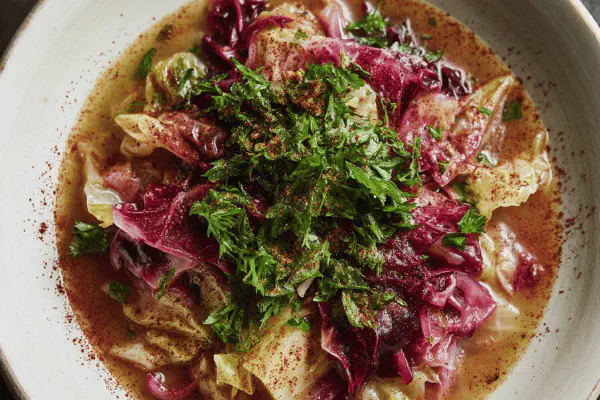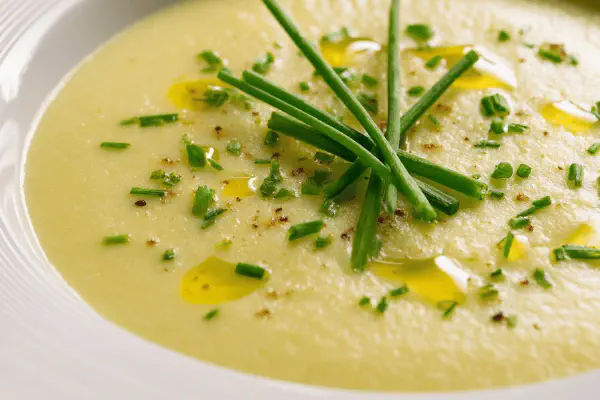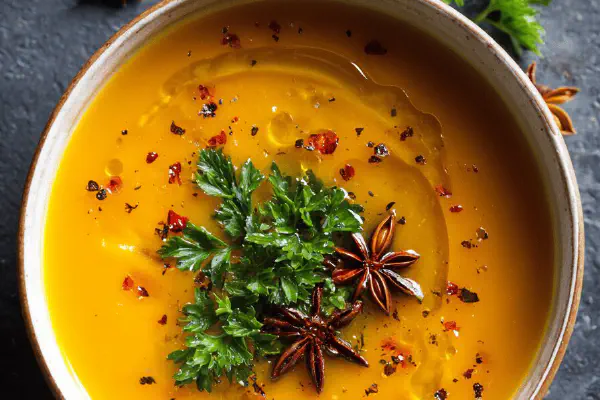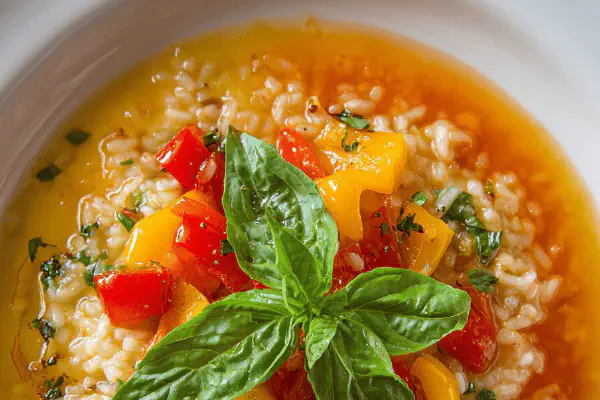Lobster White Chocolate Soup
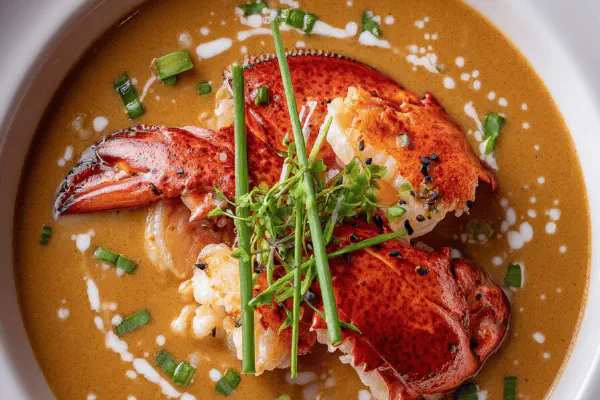
E
By Emma
Certified Culinary Professional
•
Recipe tested & approved
A delicate seafood broth with a hint of white chocolate, blended with striped bass and lobster meat. The chocolate melts into the fumet creating a creamy texture without cream. Egg yolk thickens gently. The soup is finished with tender fish cubes and sweet lobster chunks. Pinches of green onion add brightness. Cooking low and slow keeps the fish firm and juicy. No nuts, gluten free, subtle sweetness meets briny richness. Lobster claws split for garnish, visual punch. Originally fish fumet, chocolate white replaced partly by white cocoa butter for softer sweetness and less dairy tone. Egg yolk swapped partly to mascarpone for silkier mouthfeel. 4 portions.
Prep:
25 min
Cook:
12 min
Total:
37 min
Servings:
4 servings
#seafood
#soup
#lobster
#white chocolate
#French-inspired
#mascarpone
#striped bass
Started with fumet as base. Tried straight white chocolate first, came out cloying or grainy when overheated. Learned to melt it off heat, then temper in yolk and mascarpone—stabilizer duo. Fish texture is crucial here, watched carefully, no boiling or it toughens fast. Lobster adds sweetness; near the end or meat dries out. Earlier, I thought lobster claw meat could be incorporated, but better torn apart last-minute and set aside as garnish. The visual cue and textural contrast elevate this almost by accident. Onion gives a green flash among pale colors, breaks monotony. The whole is subtle, almost enigmatic but rewarding if timed right.
Ingredients
- 525 ml (2 1/4 cups) fish stock or fumet
- 30 g (1 1/16 oz) white chocolate, finely chopped
- 1 egg yolk plus 1 tbsp mascarpone
- 150 g (5 1/4 oz) striped bass or Chilean sea bass, diced
- 1 cooked lobster about 600 g (1 1/3 lb), meat shredded; reserve whole claws
- 1 scallion, thinly sliced
- Salt and white pepper to taste
About the ingredients
Fish stock quality makes or breaks. Use homemade fumet if possible; canned seafood broth too salty or bland. White chocolate: no substitutions to mimic its fatty, sweet lipids—don’t try cocoa butter blocks alone unless finely chopped and balanced. Mascarpone replaces part yolk to avoid scrambling - if unavailable, crème fraîche will do but adds tang. Bass choice depends on availability; Chilean sea bass fattier, cooks quickly. Lobster meat can be swap with large cooked crab chunks for earthy twist, though flavor differs. Scallion optional but heightens the finish. Salt carefully; broth and shellfish bring natural saltiness. Timing: eyeball fish doneness, opaque flesh and gentle flakes—not sticking but firm.
Method
- Heat fish stock in saucepan until it bubbles gently, not a rolling boil. Remove from heat immediately once small bubbles appear on the surface. This stops over reduction and bitterness.
- Whisk egg yolk with mascarpone in a small bowl until combined. Add chopped white chocolate to hot stock gradually, stirring constantly. Incorporate yolk mixture slowly, keep stirring vigorously; prevents curdling and ensures silky texture.
- Return mixture to very low heat. Add diced bass and shredded lobster meat. Stir continuously but do not let boil. Fish is cooked when flesh turns opaque and flakes gently, about 4 to 5 minutes. Too much heat makes fish rubbery.
- Season with salt and a pinch of white pepper. Taste for balance; white chocolate softens flavor but fish and lobster should remain star. Adjust seasoning sparingly.
- Halve lobster claws lengthwise for an elegant garnish. Serve soup hot in medium-sized coffee cups or small bowls, placing half claw on top for drama and texture.
- Optional: sprinkle sliced scallion just before serving to cut richness with freshness.
Cooking tips
Boiling broth causes bitterness, so moderate heat essential. Adding chocolate off heat avoids grainy bits—white chocolate too delicate for high temps. Whisk yolk and mascarpone well for even thickening, will protect soup from heat curdle, important step often skipped. Stirring constantly is key—settling causes lumps or overcooking fish in spots. Cook fish in soup not too long; it continues moist from residual heat. Lobster pre-cooked meat added last prevents drying, preserves sweet tenderness. Claws cut for garnish create dining experience; handle with scissors or chef’s knife carefully to preserve shape. Serve right away; soup thickens and settles on standing. Green onion last minute or they wilt and lose color. No cream added; fat from chocolate and mascarpone enough for silky mouthfeel.
Chef's notes
- 💡 Heat fish stock low; bubbles just breaking surface not rolling boil avoids bitterness. Remove instantly when tiny bubbles form. Watch closely flavors turn off fast at high heat.
- 💡 Melt white chocolate off heat or low warmth. Sudden high temps cause grainy texture. Whisk yolk and mascarpone vigorously before adding to broth for silky thickening. Stir constantly no pause prevents curdling.
- 💡 Fish cubes—use bass or Chilean sea bass fattier, cooks quicker. Add to hot broth, no boil after. Fish cues: flesh turns opaque, flakes gently. Usually 4-5 minutes max. Overcooking makes rubbery texture.
- 💡 Lobster meat shredded and added last holds sweetness, keeps tender. Claws stay whole; cut lengthwise with scissors or sharp knife for garnish. Visual and texture contrast keeps dish alive on plate.
- 💡 Season lightly; broth plus shellfish bring natural saltiness. White pepper pinch only, too much overwhelms. Scallion last minute brightens richness but adds no bitterness—slice thin and sprinkle right before serving.
Common questions
Why no rolling boil when heating stock?
Rolling boil strips flavor. Stock reduces too fast bitter notes evolve. Slow bubbles surface signal stop heat immediately. Allows gentle flavor build, no harshness.
Can I substitute mascarpone?
Crème fraîche works but adds tang more sour notes. Egg yolk alone more risk curdle. Mascarpone stabilizes smoother mouthfeel. Skip cocoa butter blocks alone—too fatty unbalanced texture.
How to avoid fish rubbery?
Watch fish closely when cooking. Add after temp drops; simmer not boil. Flesh turns opaque and flakes easily. Timed 4-5 minutes max. Carryover heat helps finish cooking gently.
How to store leftovers?
Cool quickly refrigerate up to 2 days. Reheat gently low heat no boiling. Stir often. Lobster meat can dry out reheated too long. Claws better kept separate to maintain texture.
